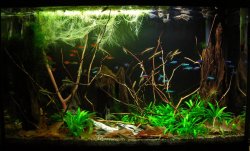Thank you!
I would absolutely love floating plants. Can I have them even though my tank has a lid? Are there types that are better suited than others?
You're most welcome. I have floating plants in all my tanks (I consider it mandatory
) and they all have covers; provided there is air circulation through normal openings, plants will have no trouble. Given the tank being 63 litres (roughly 16 gallons), I would suggest floating plants that are a bit easier to control. Something like Water Sprite (
Ceratopteris cornuta, the true floating species) for example can get very large although you can manage this by removing some of the daughter plants that grow from alternate leaves regularly and discarding the larger plant(s). Frogbit is another. Water lettuce (
Pistia stratiotes) similar. These three are true floating plants, meaning they establish good floating leaves and have nice root masses dangling down into the water.
There are smaller floaters, like duckweed and
Salvinia. I like both of these in certain situations, but being so tiny they can get lost, and duckweed really can explode like a weed. Salvinia will provide the better cover. But I would tend to go with the more substantial floating plants.
Some of the stem plants do very well floating. I am particularly fond of Brazilian Pennywort (
Hydrocotyle leucocephala) which will grow in long stems along the surface with the leaves lying flat and the roots from each node dangling down. It is very easy to control this plant by cutting the stems, and they will usually divide and form lovely patches.
Being at the surface, light is not usually an issue for these plants, but a good spectrum is helpful. Something around 5000K to 7000K works well. A comprehensive liquid fertilizer may help too. Floating plants are fast growers because not only the light is good, but they have the advantage of being able to assimilate CO2 from the air rather than just the water.
Byron.



